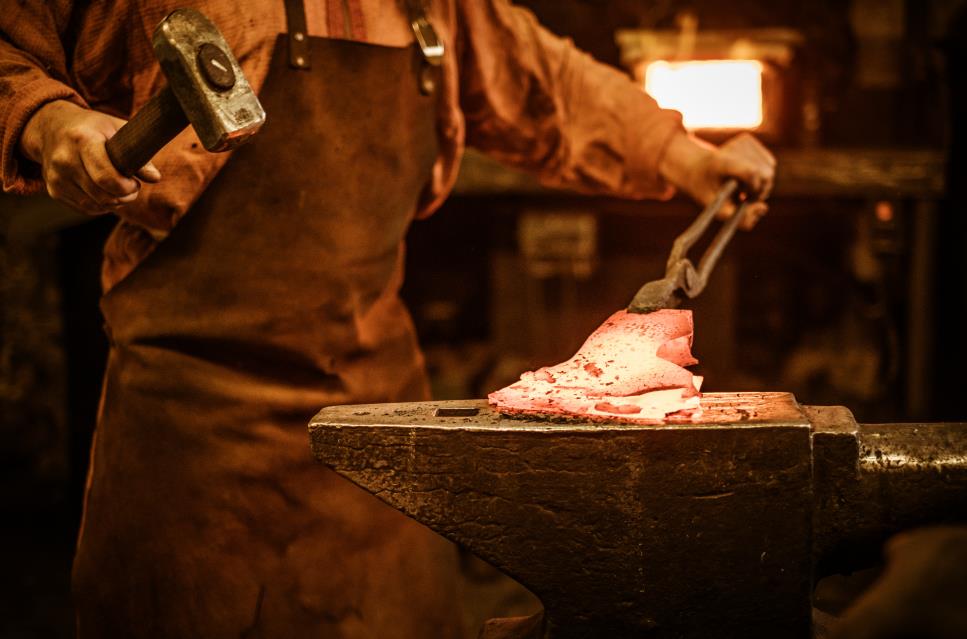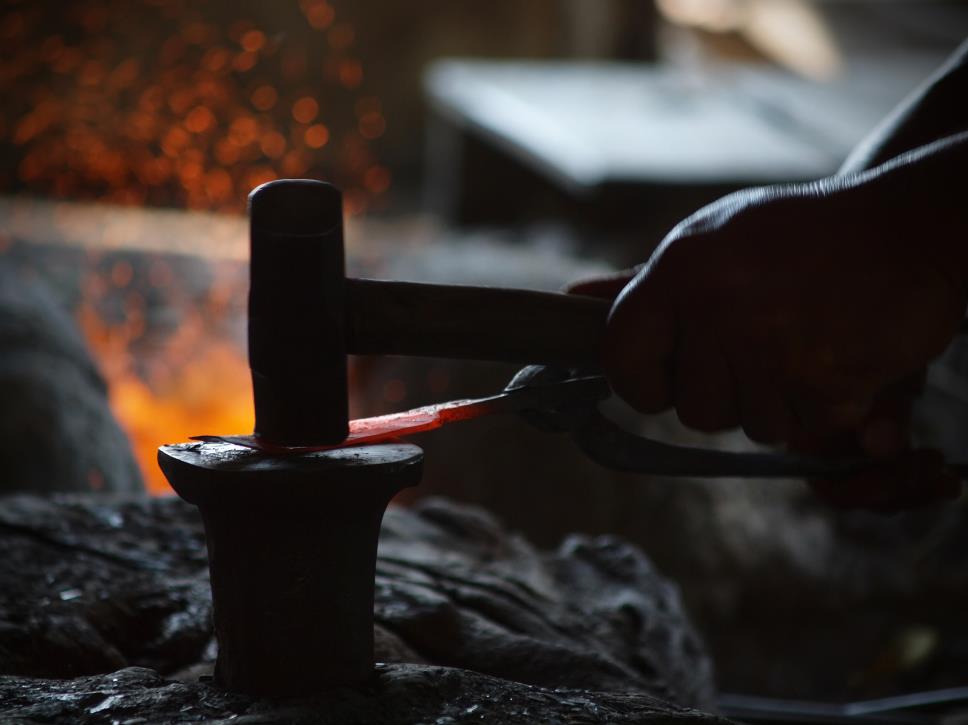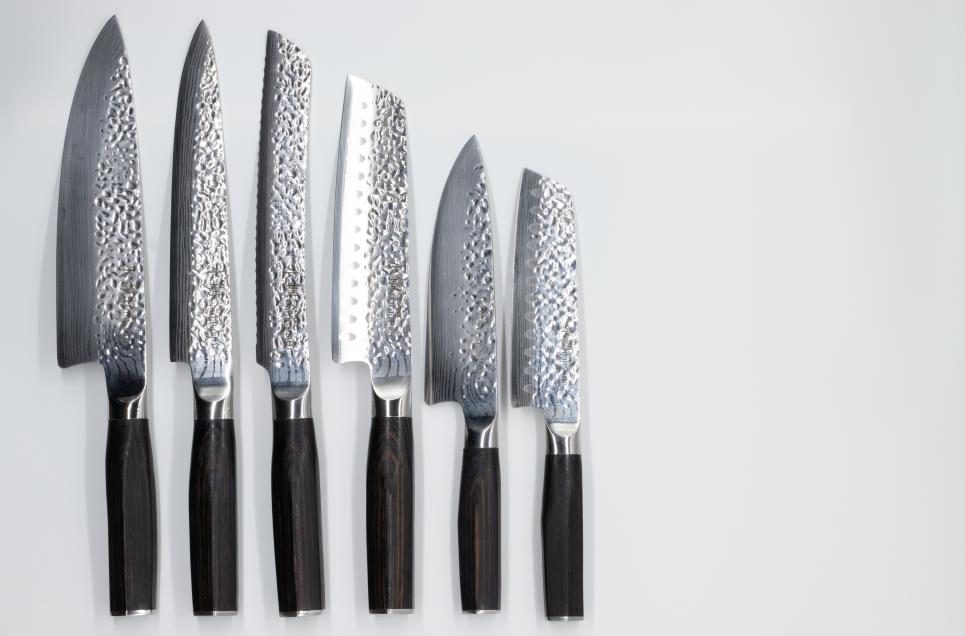The most crucial aspect of any blade is its steel. Different types of steel have varying attributes that make them better or worse for specific tasks. The type of steel determines the knife’s strength, hardness, toughness, edge retention, and overall durability, among other properties.
Unfortunately, having all these attributes in a single steel sheet is impossible. For instance, knives with high carbon steel are very hard but also brittle and prone to rusting. Stainless steel chef knives won’t rust as easily, but they don’t hold an edge as well. An attempt to solve this problem is the development of layered steel knives.
Designing a knife with multiple layers of steel brings forth a combination of attributes that would otherwise be unobtainable in a single steel type. While it won’t make the perfect knife for everyone, it does offer more versatility than most. Read on for a detailed guide on layered steel knives.
Table of contents
What is layered steel?

Two or more types of steel bonded together create layered steel. Essentially, it’s a “sandwich” of individual steel pieces welded together and forged into a single piece. Blacksmiths use a process known as austenitization, where they heat the combined metals to high temperatures, around 2,000°F until they reach an austenite state.
Austenitization is when the crystal structure of the steel changes from ferrite or pearlite to austenite. However, different steel types have varying temperature requirements to reach an austenite state. As such, knifemakers may be generous with their heating.
A layered steel knife possesses many of the same attributes as its component steels. But randomly bonding different layers of steel together won’t create a top-quality knife. For instance, forging very hard and soft steel types creates a blade that cuts unevenly. Instead, blacksmiths use specific layering techniques to produce the best results.
There exist two common types of layered steel:
- Three layered (San Mai or clad)
- Multi-layered (Damascus)
Three-layered steel (San Mai or clad)
Ancient Japanese blacksmiths dating back to the 13th century were the first to utilize three-layered steel in their blades. Previously, using hard steel was the only option if you wanted your knife to stay sharp for a long time. Unfortunately, hard steel is also brittle, and a drop or a hard blow could easily damage the blade.
What is three-layered steel?
To solve the problem of brittleness, blacksmiths came up with the idea of combining a hard steel core with a softer layer of steel on each side of the blade. This process is what most refer to as the “San Mai” technique in Japanese.
Process of making three layered steel

Making three-layered steel involves forge-welding a billet (a long metal rod) of hard steel in the middle, with two softer layers of steel on either side. Jacketing the hard steel with tough steel alleviates the brittleness issue while providing extra edge retention. Once the three pieces are forged, the billet is hammered until it becomes thin enough to form a blade.
Grinding the edge of the blade to a sharp point completes the process. You’ll notice a visible line running along the length of the blade, which is where the three layers of steel meet. While some knife makers will forge the knives from start to finish, others use pre-laminated San Mai sheets and cut-out knife shapes.
Three-layered steel knives are some of the most durable options on the market. They hold the edge longer and absorb impacts better than most other knives.
What does three-layered steel do?
The design construction of a three-layered steel knife ensures lasting durability with unmatched sharpness. The outer cladding of softer steel protects the harder, more brittle steel core from chipping. The hard steel in the center provides excellent edge retention, while the softer steel on either side ensures that the blade is tough enough to withstand impacts without chipping.
While three-layered steel knives are not entirely indestructible, they provide the best of both worlds. One way users can tell if their blade is three-layered is if there is a line running along the blade. Or they can use acid etching, essentially dipping the blade in acid, revealing the different layers of steel.
Multi-layered steel (Damascus)
Another common type of layered steel is multi-layered steel or Damascus. The origin of Damascus steel is quite contentious, with various theories abound. Some believe the technique was first used in India, while others claim it originated in Syria.
What is multi-layered steel (Damascus steel blade)?
Multi-layered steel, or Damascus steel, is a type of steel containing several layers of different metals forge-welded together. The word “Damascus” is often used interchangeably with “wootz steel” or used together as ” wootz Damascus steel.” However, the original formula for true Damascus steel has been lost to history.
Still, it remains one of the most revered metals in knife making. The closest modern approximation of the original Damascus steel is called “pattern-welded” or “twist” Damascus. Unlike three-layered steel, which only has three layers, multi-layered Damascus can have hundreds or even thousands of layers.
The process of making modern Damascus steel
Pattern welding is forging multiple steel billets of different types to create one billet. Hammering this billet aligns the grain structure of the metals in a specific pattern. The billet is then twisted to create a unique spiral pattern that can be pretty mesmerizing. However, the patterns don’t show immediately.
Knifemakers proceed to shape and grind the Damascus into the desired blade shape. The next step is to etch the blade with an acid bath like ferric chloride, which reveals the mesmerizing patterns of the layered metals. These patterns look similar to those of the original Damascus steel, which is why it’s also called “pattern-welded” Damascus.
Knifemakers can achieve different patterns of Damascus steel by varying the types of metals used, the number of layers, the number of twists, and the grind angle. The multi-layer forging process is quite labor intensive. The process has very long lead times, often weeks if not several days. As a result, multi-layered steel knives are usually pricier than other types of knives.
What does multi-layered steel do?

The visually striking patterns of multi-layered steel knives are not just for show. However, they’re the most significant selling points. Damascus patterns occur randomly, meaning there are no two multi-layered steel knives that look exactly alike. The uniqueness of each blade is what draws many knife enthusiasts to Damascus knives.
The different steel alloys used in Damascus steel give the kitchen knives unique properties. The variations in hardness and toughness create a blade that can withstand impacts and maintain a razor-sharp edge for a long time. However, depending on the type of steel used during forge welding, the opposite can also be true.
As such, knifemakers must be careful when selecting the alloys for their multi-layered steel. They must ensure that the steel alloys complement each other to create a tough and durable blade. If done correctly, Damascus steel can make a knife that is both hard and tough, with excellent edge retention.
Should you buy layered steel knives?
Now that you know the two main types of layered steel and the process involved in making them, you might wonder if you should buy one of these knives. Comparing layered steel knives to other kinds of knives boils down to personal preference. While layered or clad on blades may improve certain properties, some users may look for a knife with a specific feature.
Handpicked for you
True cutting power in the palm of your hand
A Damascus knife is an excellent choice if you’re looking for a knife that will turn heads. The mesmerizing patterns of the layered steel are like no other. But not everyone is looking for a flashy knife. Some users prefer the more subdued look of a simple stainless steel blade.
If you’re after performance, layered steel is still worth considering. But performance is subject to the specific steel alloys used in the knife. For instance, you can still get a mono steel knife with excellent edge retention without paying the premium for a layered steel knife.
Even so, layered steel knives offer a uniqueness that mono steel knives can’t match. The sharpness, edge retention, and toughness make them worth the dime for more frequent users.
Closing
Hopefully, from this article, you now know the different types of layered steel and the process involved in the design and manufacture. You should also better understand how these knives perform and why they cost more than other types. Consider your needs as a user; if you are undecided about layered steel knives, and when you finally decide, ensure you buy from a seller with excellent reviews.
And if layered steel knives are not your thing, you can check out our HDMD store and browse through our selection of high-quality high-carbon steel knives. Our HDMD blog has more information on different types of knives and their features.












